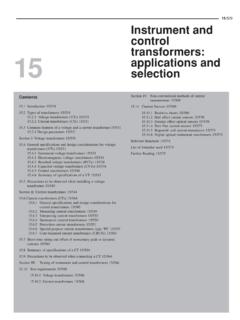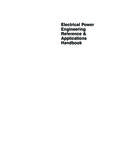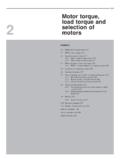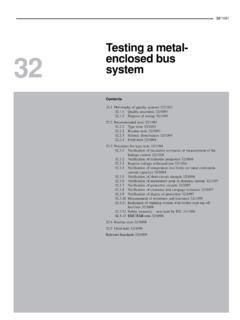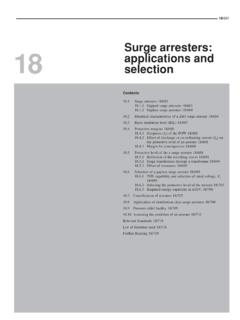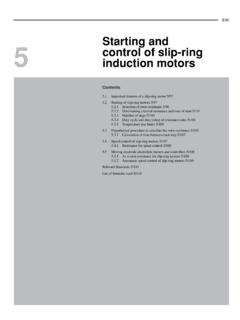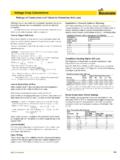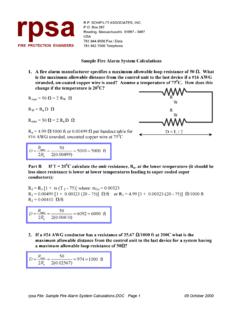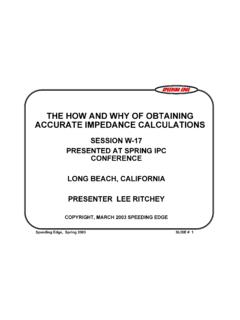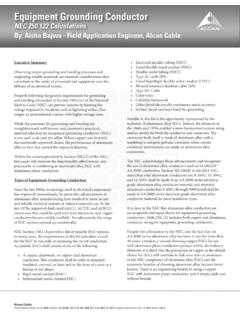Transcription of Part V - Electrical Engineering Book
1 Part VBusbar Introduction 28 Types of metal-enclosed bus systems 28 A non-segregated phase bus system 28 A segregated phase bus system 28 An isolated phase bus (IPB) system 28 A rising mains (vertical bus system) 28 An overhead bus (horizontal bus system) 28 Non-conventional, compact and low loss bus systems 28 Design parameters and service conditions for a metal-enclosed bussystem 28 Design parameters 28 Short-circuit effects 28 Thermal effects 28 Electrodynamic effects 28 Service conditions 28 Ambient temperature 28 Altitude 28 Atmospheric conditions 28 Excessive vibrations and seismic effects 28 Other design considerations 28 Size of enclosure 28 Voltage drop 28 Skin and proximity effects on a current-carrying conductor28 Skin effect 28 Skin effect analysis 28 Determining the skin effect 28 Proximity effect 28 Proximity effect in terms
2 Of busbar reactance 28 Voltage unbalance as a consequence of the proximity effect28 Derating due to the proximity effect 28 Minimizing the proximity effect 28 Energy saving 28 Sample calculations for designing a 2500 A non-isolated phasealuminium busbar system 28/1025 Relevant Standards 28/1036 List of formulae used 28/1037 Further Reading 28/103728 Carrying powerthrough metal-enclosed bussystems28/983 Carrying power through metal-enclosed bus systems28 IntroductionIn a power-generating station power is carried from thegenerator to the power transformer, to the unit auxiliarytransformer (UAT) or to the unit auxiliary switchgear asillustrated in Figure through solid conductors (HVbus systems).
3 This is due to large capacity of the generators(up to 1000 MW). The transmission of such large amountsof power over long distances is then through overheadlines or underground , for a distribution system of , or 11kV and even higher such as 33 or 66 kV, feeding largecommercial or industrial loads, the distribution of poweron the LV side (Figure ) may be through cables orsolid conductors (LV bus systems), depending upon thesize of the transformer. The HV side of the transformermay also be connected through cables or the HV bussystem as moderate ratings on LV system, say, up to 600/800 A, cables are preferred, while for higher ratings (1000 Aand above), the practice is to opt for solid conductors(LV bus systems), on the grounds of cost, appearance,safety, ease of handling and maintenance.
4 For larger ratings,more cables in parallel may become unwieldy and difficultto maintain and present problems in locating faults. Thebusbar conductors may be of aluminium or copper. Theuse of copper may be more appropriate at corrosive areas(such as humid, saline or chemically aggressive locations).In humid and corrosive conditions, aluminium erodes fasterthan solid or hollow conductors connect the supplyside to the receiving end and are called bus ducts. Theymay be of the open type, such as to feed a very highcurrent at very low voltage. A smelter unit is one suchapplication. But normally they are housed in a sheetmetal enclosure, Figures (a) and (b).
5 Our main concern here will be dealing with large tovery large currents, rather than voltages. Currents aremore difficult to handle than voltages due to mutualinduction between the conductors and between theconductor and the enclosure. Here we briefly discuss thetypes of metal-enclosed bus systems and their designparameters, to select the correct size and type of aluminiumor copper sections and the bus enclosure for the requiredapplication, current rating and voltage system. Moreapplications, illustrations are provided for aluminiumconductors rather than copper, as they are more commonlyused on grounds of cost, but adequate data and tables areprovided to design a copper busbar system Types of metal-enclosed bussystemsA bus system can be one of the following types, dependingupon its application.
6 Non-segregated Segregated Isolated phase Rising mains (vertical bus systems) Overhead bus (horizontal bus system) Non-conventional bus systems(1) Compact and sandwich type(2) Partially isolated phase bus (PIPB) type(3) Gas (SF6) insulated busbars (GIB) A non-segregated phase bus systemIn this construction all the bus phases are housed in onemetallic enclosure, with adequate spacings between themand the enclosure but without any barriers between thephases (Figure (a)).ApplicationBeing simple and economical, it is the most widely usedconstruction for all types of LV systems. The latest trendnow is to go in for compact bus systems where possible,in view of their inherent advantages noted current ratingsThe preferred current ratings may follow series R-10 ofIEC 60059 and as discussed in Section (4).
7 Theymay increase to 6000 A or so, depending upon theapplication like when required to connect a large LValternator or the LV side of a large transformer to itsswitchgear. The preferred short-time ratings may be oneof those indicated in Table kVtransformerCable orbus duct*Bus ductLVbreakerLV power control centre (PCC)* 11 kV breaker for isolation and protection of transformer andinterconnecting cablesFigure of a bus system28/986 Electrical Power Engineering Reference & Applications A segregated phase bus systemIn this construction all the phases are housed in onemetallic enclosure as earlier, but with a metallic barrierbetween each phase, as illustrated in Figure (b).
8 Themetallic barriers provide the required magnetic shieldingand isolate the busbars magnetically from each other,like an isolated phase bus system (IPB). The metallicbarriers transform the enclosure into somewhat likeFaraday Cages (Section ). For more details seeSection The enclosure can be of MS or aluminiumand the barriers also of the same metal as the enclosureto provide uniform distribution of field. The purpose ofproviding a metallic barrier is not only to shroud thephases against short-circuits but also reduce the effect ofproximity of one phase on the other by arresting themagnetic field produced by the current carrying conductorswithin the enclosure itself.
9 It now operates like anenclosure with an interleaving arrangement ( ) balancing the fields produced by the conductorsto a great extent and allowing only a moderate field inthe space, as in an IPB system (Section ). Theenclosure losses with such an arrangement may fall inthe range of 60 65% of conductors in case of (mildsteel) and 30 35% in case of aluminium enclosures forall voltage systems 11 kV and current ratings above3000 A and up to 6000 A or so. Only aluminium enclosuresshould be preferred to minimize losses and enclosureheating. The effect of proximity is now almost nullifiedas also an imbalance in the phase reactances.
10 An unbalancein the reactance is otherwise responsible for a voltageunbalance between the three phases as discussed in and enhance the electrodynamic forces that maylead to a phase-to-phase fault at higher rated are generally used for higher ratings, 3000 A andabove, on all voltage systems. They are, however, preferredon an HV rather than an LV system, such as between aunit auxiliary transformer (UAT) and its switchgears anda station transformer and its switchgears as in a power-generating station and shown in Figure , for reasonsof safety and also cost of an isolated phase bus system(IPB) (Chapter 31) over a segregated the availability of compact and partially isolatedFlangeEnclosureBusbarsBusbar supportinginsulatorsRYBNNon-magnetic ormagnetic enclosureBarriers (same metalas the enclosure) Clamps (same metalas the enclosure)Figure (a)Low rating LV bus ductFigure (b)
